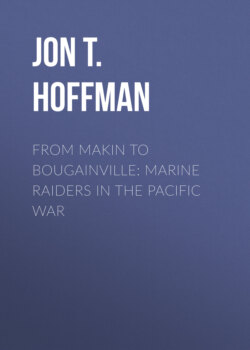Читать книгу From Makin to Bougainville: Marine Raiders in the Pacific War - Jon T. Hoffman - Страница 6
На сайте Литреса книга снята с продажи.
Оглавление[Sidebar (page 2):]
Major General Merritt A. Edson, USMC
Table of Contents
Merritt A. Edson’s military career began in the fall of 1915 when he enlisted in the 1st Vermont Infantry (a National Guard outfit). In the summer of 1916 he served in the Mexican border campaign. When the United States entered World War I in April 1917, he earned a commission as a Marine officer, but he did not arrive in France until just before the Armistice.
He ultimately more than made up for missing out on “the war to end all wars.” In 1921 he began his long career in competitive shooting as part of the 10-man team that won the National Rifle Team Trophy for the Marine Corps. He earned his pilot’s wings in 1922 and flew for five years before poor depth perception forced him back into the infantry. In 1927, he received command of the Marine detachment on board the Denver (CL 16). He and his men soon became involved in the effort to rid Nicaragua of Augusto Sandino. Edson spent 14 months ashore, most of it deep in the interior of the country. In the process, he won a reputation as an aggressive, savvy small-unit leader. He bested Sandino’s forces in more than a dozen skirmishes, earned his first Navy Cross for valor, and came away with the nickname “Red Mike” (in honor of the colorful beard he sported in the field).
Edson spent the first half of the 1930s as a tactics instructor at the Basic School for new lieutenants, and then as ordnance officer at the Philadelphia Depot of Supplies. During the summers he continued to shoot; ultimately he captained the rifle team to consecutive national championships in 1935 and 1936. In the summer of 1937 he transferred to Shanghai to become the operations officer for the 4th Marines. He arrived just in time for a ringside seat when the Sino-Japanese War engulfed that city. That gave him ample opportunity to observe Japanese combat techniques at close range. In June 1941, Red Mike assumed command of the 1st Battalion, 5th Marines at Quantico.
After his stint with the 1st Raiders and the 5th Marines on Guadalcanal, Edson remained in the Pacific He served as chief of staff of the 2d Marine Division at Tarawa, and as assistant division commander on Saipan and Tinian. During each of these campaigns he again distinguished himself under fire. Ultimately, the Marine Corps discovered that Edson’s courage was matched by his skill as a staff officer. He spent nine months as chief of staff for the Fleet Marine Force Pacific and closed out the war in charge of the Service Command.
Following the war Edson headed the effort to preserve the Marine Corps in the face of President Truman’s drive to “unify” the services. He waged a fierce campaign in the halls of Congress, in the media, and in public appearances across the nation. Finally, he resigned his commission in order to testify publicly before committees of both houses of Congress. His efforts played a key role in preserving the Marine Corps. After stints as the Commissioner of Public Safety in Vermont, and as Executive Director of the National Rifle Association, Edson died in August 1955.
